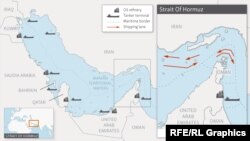A war of words has erupted again between the United States and Iran over the Strait of Hormuz. But it would be in no country’s interest to see trade disrupted in this vital international waterway. Furthermore, unilateral military action on Iran’s part would be a grave mistake.
On Monday, April 22 the United States announced it would end sanctions waivers for countries importing oil from Iran, with the object of ending all Iranian oil exports. In apparent response, Alireza Tangsiri, the head of Iran’s Revolutionary Guard Corps navy force said that “if we are prevented from using [the Hormuz Strait], we will close it. In the event of any threats, we will not have the slightest hesitation to protect and defend Iran’s waterway.”
This is not the first time Iran has used a threat to close the Strait as leverage. Last year President Hassan Rouhani said that if the United States persisted in its efforts to cut Iran’s oil exports, Tehran would see to it that no country in the region would be able to export oil. Iran’s Supreme Leader Ayatollah Ali Khamenei said Rouhani’s threat reflected the regime’s official policy. President Trump responded angrily, cautioning Iran to “never ever threaten the United States again or you will suffer consequences the like of which few throughout history have ever suffered before.”
The Hormuz Strait is a critical international waterway through which passes almost a fifth of the world’s crude oil supply. The prospect of reduced oil exports from Iran and instabilities in the region have caused a recent spike in oil prices, and the actual closure of Hormuz would be even more disruptive to energy markets.
Tehran seems to think it has nothing to lose by threatening to close the Strait. After all, if the United States can pressure other countries not to import oil from Iran, then the Islamic Republic would not lose more by closing Hormuz than leaving it open. The strategy seems to be, if Iran suffers, then the region will suffer.
However, this would be a grave error on Iran’s part. The Hormuz Strait is a protected international channel and attempting to close it by force would be illegal. Iran claims rights over the entire Strait, but most of the deep shipping lanes are in the territorial waters of Oman. More importantly, Article 37 of the United Nations Convention on the Law of the Sea (“UNCLOS”) guarantees transit passage to waterways “used for international navigation between one part of the high seas or an exclusive economic zone and another part of the high seas or an exclusive economic zone.” This would clearly apply to the Strait of Hormuz. And while the United States is not a party to the treaty it has recognized provisions of the agreement as operative parts of customary international law.
If Iran took unilateral action to prevent transit through the Strait it would constitute a casus belli for countries that utilize Hormuz for shipping, or indeed for any country seeking to enforce international rights, to do so. Perhaps Tehran believes that sympathetic countries on the United Nations Security Council like Russia would veto any attempt to authorize the use of force to reopen the Strait, but the disruption caused by the closure could be so profound that it would test even Moscow’s willingness to stand by its strategic partner. As well, the United States and countries in the Gulf region would undoubtedly be prepared to take military action regardless of whether the United Nations authorized the use of force or not. President Trump in particular would not think that the United States was legally constrained in its response to Iran’s provocations simply because the UN chose not to act.
Reopening the Strait would not be an easy task. Both the U.S. and Iran have prepared for this conflict scenario for decades. The 2002 “Millennium Challenge” wargame showed just how costly such a confrontation could be, with the U.S. Navy losing a simulated aircraft carrier and ten cruisers to Iranian unconventional attacks. Coalition naval forces would not simply rush into the Strait to be set upon by swarms of drones, small fast-attack boats, and shore-launched anti-ship missiles. There would be thorough preparation of the battlespace by air assets and special operations forces before any capital ships were placed in harm’s way.
And there is no reason to believe that the U.S. military response to a Strait closure would be limited to the Hormuz area. All Iranian military surface vessels and submarines, whether deployed or in port, would be considered legitimate targets, as well as any Iranian military aircraft. Iran’s communications infrastructure would be targeted, as well as its supply centers, command and control nodes, and high-level military leadership. An open military confrontation of this type would also support the argument for launching strategic strikes against Iran’s known or suspected nuclear facilities.
It would be a mistake for Iran to respond to economic pressure with open warfare. The renewed economic sanctions are not intended to bring about conflict but to encourage Tehran to agree to negotiations over a wide-ranging agreement to replace the flawed 2015 Joint Comprehensive Plan of Action. As the president stated last year, this proposed approach would seek to “eliminate the threat of Iran’s ballistic missile program; to stop its terrorist activities worldwide; and to block its menacing activity across the Middle East,” as well as end Iran’s nuclear ambitions. Closing the Strait of Hormuz would only further isolate Iran in the international community, hinder negotiations, and create conditions for conflict for which Tehran would pay a terrible price.









